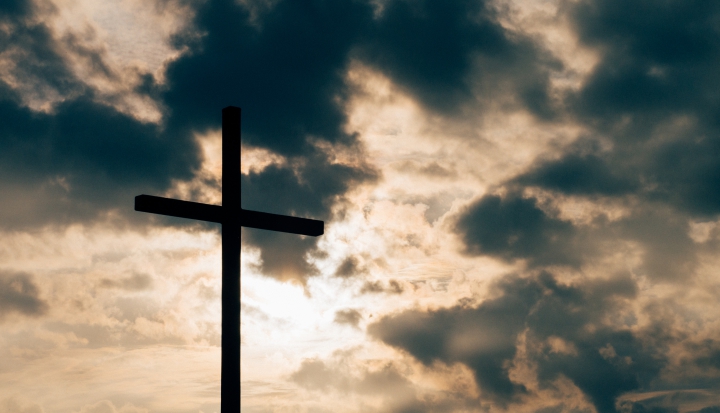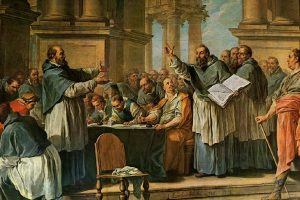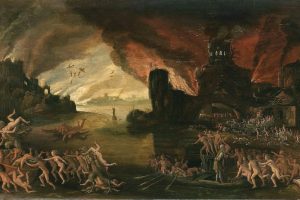Care for creation often falls low on the list of priorities for the majority of Christians, with many even vocal that environmental stewardship isn’t a Christian call. There’s something deeply wrong with that, says Elizabeth A. Johnson, one of the church’s foremost theologians of the 20th and 21st centuries. The problem lies in how we think about the redemption offered by God, which she addresses in her latest book Creation and the Cross: The Mercy of God for a Planet in Peril (Orbis).
“The goal of the book was to expand redemption in our prayer and in our faith to include all creatures, who will be with us transfigured in plentitude,” Johnson says. “We then act ethically toward the earth as a result of that and bring the earth into our narrative.”
In order to do so, she had to go back 1,000 years to when theology began to ignore creation, namely with Cur Deus Homo (“Why God Became Man”), a treatise by 11th-century Archbishop of Canterbury, Anselm. In Creation and the Cross, Johnson models the dialogue between Anselm and his student Boso with a conversation between herself and Clara, a figure who represents people whom Johnson has encountered over the years. Together they theologically “unhitch” divine mercy from the cross and mine scripture for evidence of God’s abundant mercy for all creation.
“It’s ancient, it’s scriptural, and it’s basic,” Johnson says. “It’s not completely lacking, but here in the West we just haven’t attended to it, and it’s time that we do. Urgently.”
What does the cross have to do with creation?
Theology of redemption has been mostly focused on us as humans. But Pope Francis in Laudato Si’ (On Care for Our Common Home) writes, “Each year sees the disappearance of thousands of plant and animal species which we will never know, which our children will never see, because they have been lost forever. The great majority become extinct for reasons related to human activity. Because of us, thousands of species will no longer give glory to God by their very existence, nor convey their message to us. We have no such right.”
That’s a very strong sentiment. At the very end of Laudato Si’, Francis writes, “At the end, we will find ourselves face to face with the infinite beauty of God . . . in which each creature, resplendently transfigured, will take its rightful place.”
As I started thinking about this, I went back to scripture. All throughout are narratives about the love of God for the natural world and its response to God. Even in Psalm 36, where it says, “You save humans and animals alike, O Lord.” I said to myself, “Why don’t we know this?” The absence of this awareness is therefore putting care for creation very low on all kinds of surveys of what Christians care about.
We haven’t made the animals and the natural world part of our narrative of salvation. We haven’t included them in what Christ has done. We know God created everything in the beginning, but then they disappear. Everything is all about us. So I started to write an ambitious book to get us to consider a whole new theology of redemption, starting from square one again and bringing in what’s crucial for the future of life on this planet.
As I gave lectures on this idea, everywhere I went somebody inevitably said, “You’re really wrong about all this, because we’re saved by the cross, and Jesus died to save us from our sins.”
Somebody somewhere taught very good catechism classes, because everybody knows that Jesus died to save us from our sins. It’s in every liturgy and all of our Mass prayers. This idea that salvation takes place through the cross to save us and forgive us from sins has a real grip on our collective imagination. But this seriously reduces the meaning of redemption in the Hebrew Bible and New Testament.
So, I started scratching around and what I discovered was that this idea really took hold in the West thanks to Anselm’s satisfaction theory of atonement in the 11th century.
What is Anselm’s satisfaction theory of atonement?
It is the idea that Jesus had to die a bloody and horrible death on the cross in order to save us from our sins, because God was offended by our sins and had to receive satisfaction, had to get a payback in order to forgive us. God’s honor was at stake.
How did Anselm come up with this idea?
Very simply, the way all of us come up with our ideas: from his own experience in his own world. Anselm lived in a feudal society, where there was no police force nor armies. The word of a lord was law, and this kept the civil order. If you broke a law that disturbed the order of the society in which you lived, you had to pay back something to the lord in order to restore that order. That payback was called satisfaction. You had to make satisfaction when you broke a law in order to restore the honor of the lord, on which all civic peacefulness rested.
Anselm took that political arrangement and made it cosmic. He said, “This is the way the universe works, and God is the lord of the world. Sin violates God’s word and breaks God’s law. We have to pay something back in order to restore the order of the universe.”
When Anselm is asked, “Why couldn’t God just say, ‘I forgive you’?” he said, “It would not restore the order of the universe, because we would not be seen to be repaying the honor that is due to God.” That’s how he sets up the dilemma that humans must pay back God for our sins. But we can’t do it, because God is infinite and we humans are only finite. Nothing infinite can come from us.
Here, we’re in this bind. As Anselm put it, “Only we must pay back, but only God can.” So God sends his son, who is divine, to take on our obligation.
Here’s the last part of the theory: Jesus Christ is sinless, and therefore doesn’t deserve to die. But humans deserve it because we have sinned. If Jesus had just lived his life of pure obedience to God and then was taken up into heaven without going through death, the debt would not be repaid, because every person owes God obedience and honor.
So, Jesus died freely a violent death on the cross in order to pay back something to God that God was owed but that we couldn’t pay back. Jesus shares this satisfaction with all his sisters and brothers who are sinners, and that’s how we’re all saved.
What’s wrong with this theory?
The satisfaction theory makes Jesus’ death necessary. But no one had to die for God to be merciful. It goes completely against the teaching of Jesus in the gospels. Look at the parable of the prodigal son, where a father welcomes back his son who dishonored him by spending half his fortune. When the son comes back, the father runs out, hugs him, and throws a party. Complete mercy. According to Anselm’s theory, that father should have said, “Now go out in the field and work for a number of years until you pay back what you owe me.”
Anselm was trying to make sense of the cross for people who were asking questions. He did so by calling on the political system of his day. But it runs right against the gospels. People, including Thomas Aquinas, criticized Anselm for making it necessary that Jesus do this, for taking away God’s freedom to be merciful.
At that same time in history, we start to see the sacrament of penance coming into play. This is how you could get some of that satisfaction that Christ won on the cross: by being sorry for your sins and doing penance. Then satisfaction got connected with the sacraments, with practice in the church and the Eucharist. The liturgical prayers were then written with the idea of satisfaction. And it got connected with a tremendous number of sermons.
In other words, the idea of satisfaction worked its way very rapidly into all the nooks and crannies of how Catholics believed and lived their faith.
Did Anselm leave out the resurrection?
The first time I taught Anselem’s Cur Deus Homo, I got to the end and thought, “I don’t think he mentioned the resurrection.” I went back and didn’t find it anywhere. Sure enough, everything has to do with the death of Jesus, because that was the payment.
If you compare that to the testimonies of the resurrection experience in the New Testament, the death was a disaster, not the point. It was all over for his followers. As the disciples going to Emmaus said, “We had hoped he was the one, but we’re going home, because he wasn’t.”
If the resurrection hadn’t happened, if they hadn’t experienced the risen Christ, there’d be no Christianity. If Jesus’ death did not issue in some new act on the part of God to bring life out of that tragedy, there’s no Christianity. But the resurrection is incidental in Anselm’s treatise.
When you look at our liturgical seasons, when you get to Holy Week and the triduum, the Easter Vigil is over the top, the highest liturgy of the year. It’s all about what God has done in the face of this horrible violence. God has overcome it. Without that, there’s no Christian good news.
What does scripture have to say about divine redemption?
All through the Christian Old Testament, the Jewish scriptures, once you start asking the question, it strikes you clearly: God is the merciful redeemer of the whole world. The merciful God who frees the slaves, loves the animals, and walks with people in their troubles is the God of the Old Testament. In Exodus 34, when Moses is on Mount Sinai, he encounters God who says, “The Lord, the Lord, a God merciful and gracious, slow to anger, and abounding in steadfast love and faithfulness.”
That phrase and those adjectives repeat innumerable times in the Psalms and also in the prophets. The biblical scholar Walter Brueggemann calls that text “a credo of adjectives about the character of God.”
“Merciful and gracious, slow to anger, and abounding in steadfast love and faithfulness”: Over and over again, that’s the God of the biblical story that the Jewish people keep presenting to the world over centuries of their own experience of life, history, tragedy, and coming back from tragedy. That’s the God Jesus believed in.
What does the life—not just the death—of Jesus say about God’s mercy?
If Anselm’s right, we need only one chapter out of each gospel, right? The whole life of Jesus—the way he preached, healed, stood up for those on the margins, had conflicts with those in power, and tried to live faithfully to what he was being called in his own prophetic ministry—that’s what leads him to the cross.
St. Óscar Romero, Martin Luther King, and some of the women in El Salvador lived that type of vocation—and not only Christians. State power oppresses people as we speak. Look at all the places that are jailing journalists. A journalist could walk away and say, “All right, I’m not going to tell these stories of oppressions,” but they tell them and end up in jail—or murdered.
What we have in the New Testament is a ministry that blazed like a meteor. It was very short, a year according to Matthew, Mark, and Luke; three years according to John. Jesus burst out of that carpenter shop after being baptized by John and started this ministry.
People just rallied, because what he was saying touched a nerve. They knew in their hearts that this is what they were looking for. It was such good news. There’s joy breaking out wherever he goes: all the parables and the way he shared table companionship with sinners and prostitutes and told the prostitutes they’d go to heaven ahead of those who were in charge of the law.
All these things are very radical in their own way. They present, in fact, the roadmap for Christian life: caring for your neighbor and not just the person in your family whom you love but the stranger and even the enemy.
If you leave out the life of Jesus, all that gets wiped away. All you do is focus on the cross and suffering, and what a Christian life should be disappears.
Did Jesus preach redemption for all of creation?
Let me put it this way: The New Testament doesn’t say very much and neither does Jesus about all of creation, because the early Christians just assumed the Jewish theology of creation and that all creation will be saved. In other words, you don’t have to reinvent the wheel when it’s your whole tradition already.
What Jesus did do whenever he spoke about creation was show that it was the recipient of God’s loving and merciful care.
It’s especially those texts about the sparrow, the little bird that falls to the ground dead. You could buy two of these little birds for a penny in Matthew’s gospel. Not even such a useless, worthless, little creature will fall to the ground without your heavenly Father knowing. Then in Luke’s gospel, not one of them is forgotten in God’s sight.
In Jesus’ own approach, he’s very Jewish in seeing everything included in the Creator God who made everything. God is not going to abandon the creation he made and loved, but is going to see it through to the end, even beyond death. The prophets describe what the new creation will be like: The deserts will bloom and all of nature will flourish.
Jesus never preached about this; he just assumed it. He took it for granted. That was his faith.
So Jesus wasn’t a pascal sacrifice?
One of the ways the disciples attempted to understand the death of Jesus was through the sacrifice of the lambs in the temple. The connection between the lambs’ bloody death and sacrifice was another way of interpreting Jesus’ death. When Jews sacrificed lambs in the temple, did they think they were making satisfaction to God? The answer is no. Even though an animal is sacrificed, it’s not to pay back God. People sacrificed fruits, the first of their harvest. They sacrificed grain, they sacrificed incense, and so on. There were four different occasions when these sacrifices would be made.
Bringing something to the temple and sacrificing it originally meant sharing something that God gave to you back with God in gratitude. There’s a thanksgiving that goes on mainly.
Sometimes if somebody committed a sin and wanted to get right with God, they would bring what was called a sin offering. What you were doing was trying in a way to reset your relationship with God once you had broken it. It wasn’t that God needed to be placated this way, but you needed to say you were sorry.
It’s very similar in its own way to the theology of the sacrament of reconciliation. Telling your sins to the priest, being sorry, and doing a penance doesn’t make God merciful. God is already merciful. Reconciliation is something that we do as human beings to reenact getting back on track in our relationship with God.
It’s a re-consecration, a rededication, a setting back on the right path in this relationship. It’s a human thing. It is not required to change God’s mind from anger to mercy.
What do you mean when you say that the resurrection of Jesus creates a new future for all of creation?
You have to start out by saying that you can’t imagine the resurrection, and the problem when you do try to imagine it is that you get into an impossible dead end. None of us has died and been able to come back and tell the rest of us about it. It’s a future that’s shrouded in darkness. As Paul says, “Eye has not seen, nor ear heard, nor has it entered into the hearts of people what God has prepared for those who love him.” We can’t imagine what it’s like not to be bound by time and space when we live in our bodies on this planet.
Images of light or the bursting forth of new life of flowers are good metaphors. Some people find a great deal of value in thinking of the caterpillar who spins a pupa, goes into that pupal stage, totally disintegrates, and then emerges as this butterfly. It’s the same insect, but you would never know it. Completely different, not only in what it looks like but in what it can do. The butterfly can fly. The resurrection is like that.
To believe in the resurrection is not to believe in a scientific miracle. It is to believe in God. It is an act of hope in the God who created you and everyone else and everything else, who has the love and the power still to recreate, even when death has taken away the only life that you know.
When we die we are not annihilated because God is still there. There is more life. The disciples experienced that with the resurrection of Jesus, who they thought was gone forever. He’s with them wherever two or three are gathered. He’s there in the stranger who’s hungry or thirsty. He’s there in the Eucharist. He’s there.
There are all kinds of patterns of Christ’s presence, pouring through the power of the Spirit, powering ahead through time, ever since this happened in the first century. The good news is that God is a God of light and loves the flesh, and knows what it is to die, and is accompanying every creature through death, with the hope of more.
Paul uses a good metaphor in 1 Corinthians 15 where he says that when you plant a seed what you get in the end in terms of grain looks very different, and in order for that seed to produce that grain, it had to die. It has to disintegrate and break open and its interior has to put down roots and put up a shoot, and then you get this new thing. It’s the same creature, but it’s very transformed. When you plant the body when someone dies (that’s his analogy), it undergoes transformation and what God brings to life is transformed.
Especially in death. That’s the point. And we are to care for every life, recognizing God’s love for all creation. That’s the point of my book. In the last chapter I say when we say us in our prayers, the “us” is not just Catholics and not just humans, but all living creatures.
How can we shift our thinking away from a theology of atonement?
Instead of the satisfaction theory, let us see salvation in terms of accompaniment. By the end of the first century, people came to the realization that Jesus, as seen in John’s Gospel, was how the God of gracious, saving mercy had personally joined the flesh of the world, lived among us, and was put to death. He’s Emmanuel, “God with us,” or, as John put it, “the Word was made flesh.”
Therefore, what we go through by way of agony and suffering is not unknown to God. God, who created everything, chose to join the world’s suffering, undergo it, and know what it means from the inside.
The whole point of saying “the Word became flesh” is to expand it beyond just humans. Flesh goes all through the Old Testament to describe everything that’s alive, including animals and even vegetation. When the Psalms talk about all flesh, they mean all living creatures.
The Word became flesh. What we’re saying in theology today is “deep incarnation.” The incarnation doesn’t mean that the Word of God became a human being, but that the Word of God became flesh, which is a broader category identified with all of life that lives, is beautiful, and then suffers and dies. There’s a whole lot of theology going on in the idea that God is with every creature that suffers and dies.
Pope Francis puts this in Laudato Si’, too. Whether the creature only lives a few minutes or a long life, they belong to God, and God is with them. That’s the accompaniment: the presence of God with all beings in their life and their death, with the hope that there is something more.
There’s nothing really radical in that idea. We just have to put it in this framework where all of creation is redeemed in Christ.
This article also appears in the December 2018 issue of U.S. Catholic (Vol. 83, No. 12, pages 28–32).
Image: Aaron Burden on Unsplash













Add comment